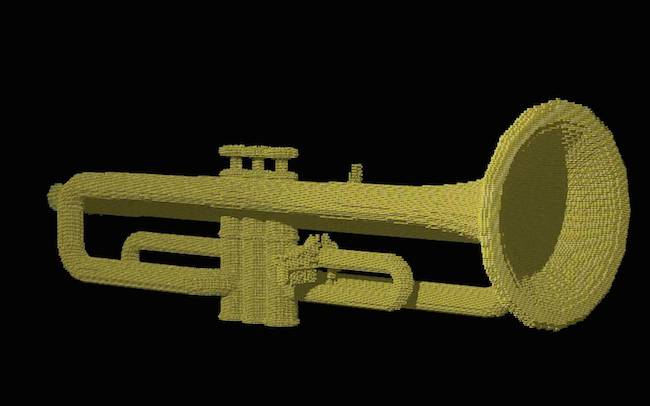It seems like we’re just starting to realize the potential of 3D printing, but there’s something even more revolutionary on the way. But before you start looking for actual clay, we should let you know that this is inspired by the material and they way that the tiny particles of clay make the mass so plastic and free to form.
Above image: A rendering of how “catoms” could be programmed to make a model of a trumpet.
Imagine if you could manifest a model in front of you in moments, shape it with your hands and change its size and color with a touch. Now, imagine if the model was a replica of someone miles away, who you could have a face-to-face conversation with, who you could see, hear and even shake hands with.
This technology, still in its infancy — scratch that— still in its zygote stage, is called Claytronics. It’s the science of programming atoms to arrange themselves into shapes. At the risk of sounding too reductive it appears as though the idea is a combination of 3D printing and nanorobotics. Thankfully, I have organizations like the International Association of Physics Students who can break the concept down for people like myself, who somehow managed to pass high school physics and never looked back .
“The challenge of claytronics is to develop tiny robots called claytronic atoms-catoms and to find how to make the catoms communicate with each other to form interchangeable objects. In analogy with atoms from which matter consists, catoms represent the smallest indivisible units of programmable matter. It is a self-contained structure that has an antenna, a processing unit, sensors, and some mechanism for adhering to other catoms.
“Catoms can be programmed to form interesting dynamic shapes and configurations. They also can be used as a system for exploring the computer science of programmable matter.
“Instead of having to buy a premanufactured object we would just download the design and with the help claytronics it would form into different things. One of the key challenges is figuring out how to program millions or billions of processors that are all working together. To find out how catoms can work together, researchers have created computer simulation so the catoms can interact with the forces of physics in a virtual environment.”
This work has been spearheaded by Seth Goldstein and Todd C. Mowry over at Carnegie Mellon University. And while, to my knowledge, they haven’t created an object in this fashion, they’re making strides to eventually do so through computer simulations and creating robots that can use magnets to link up on a 2D plane.
For a little more information into the research, please check out the illuminating Discovery Channel piece on Claytronics linked below.
Bill Rodgers is a Contributing Editor at CFile.
Any thoughts about this post? Share yours in the comment box below.

Add your valued opinion to this post.